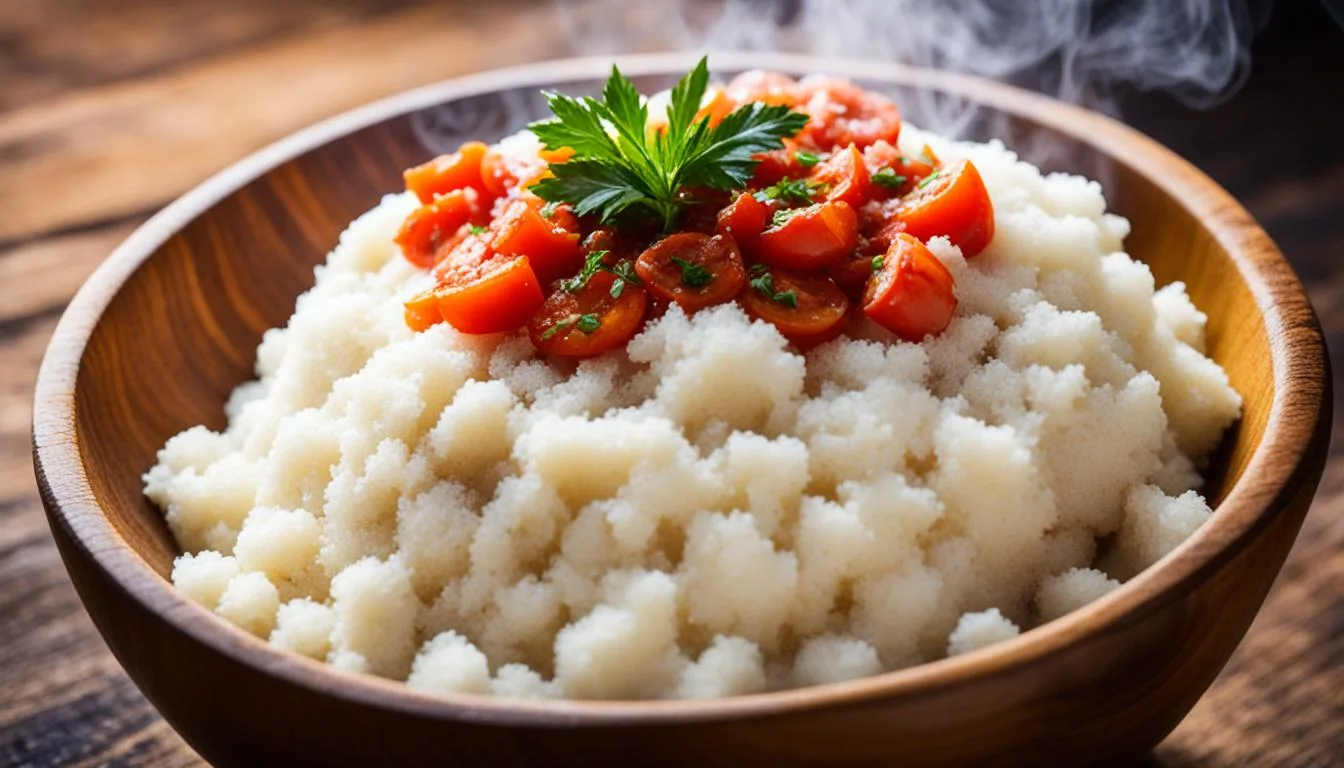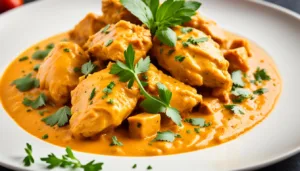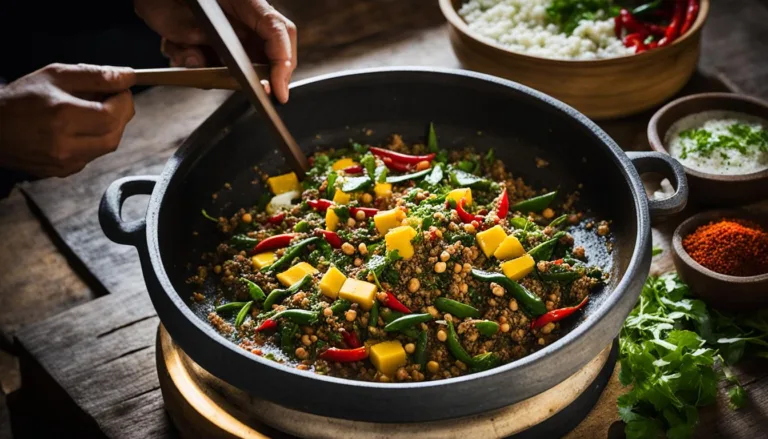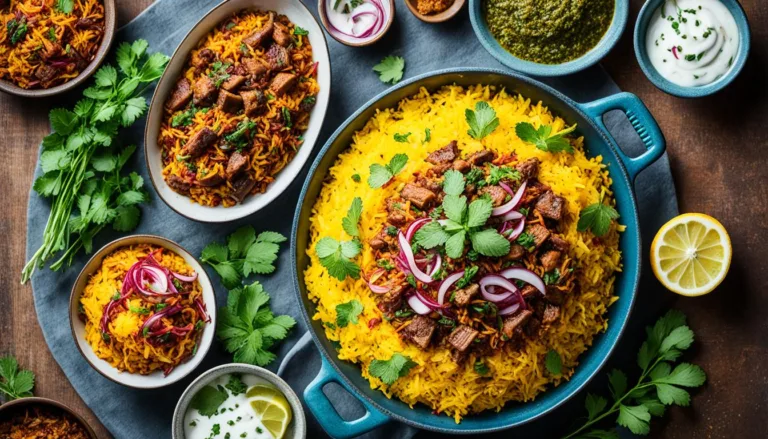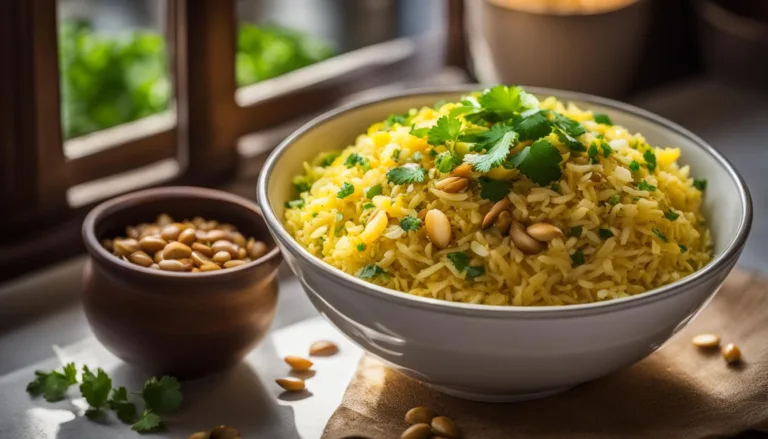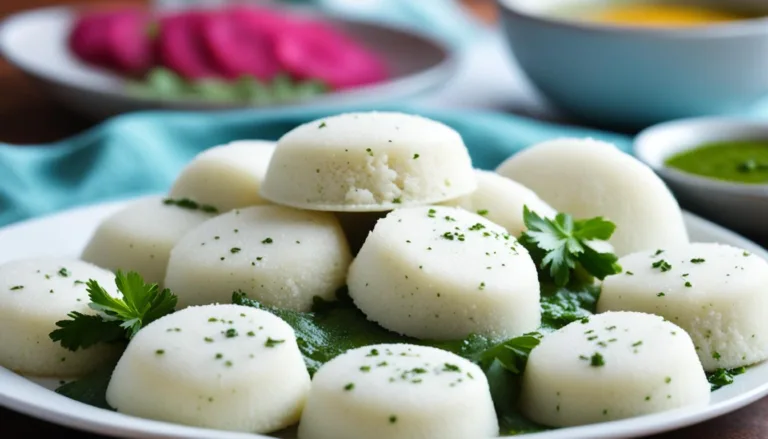In this comprehensive Ugali recipe guide, we will take you through the steps to make a simple and delicious Ugali. Whether you’re a beginner or a seasoned cook, this recipe is perfect for you. We’ll provide all the details and tips you need to create a perfect Ugali every time.
Ugali, a staple of East African cuisine, is not only flavorful but also incredibly versatile. Whether you’re enjoying it with sukuma wiki, grilled meat, or vegetable stews, Ugali is the perfect accompaniment to a wide range of dishes. Now, let’s dive into the wonderful world of Ugali!
Table of Contents
Key Takeaways:
- Learn how to make a simple and delicious Ugali with our step-by-step guide.
- Discover the origins and cultural significance of Ugali in East African cuisine.
- Understand the essential ingredients and cooking techniques for perfect Ugali every time.
- Explore the variations of Ugali made with different types of flours.
- Find out the best pairings and serving suggestions for Ugali.
Discovering Ugali: A Staple of East African Cuisine
In this section, we will explore the origins and cultural significance of Ugali in East African cuisine. Ugali is a traditional staple food that holds a special place in the hearts and stomachs of the people in this region. Let’s dive into the journey of this beloved dish and discover its historical background and cultural importance across different regions.
What is Ugali?
Ugali is a simple and versatile cornmeal-based dish that is a staple in the diet of many East African countries. Also known as sima, nsima, or sadza in different regions, Ugali is made by cooking finely ground maize flour or cornmeal in water to create a thick, porridge-like consistency. This basic mixture is often served alongside a variety of dishes, providing sustenance and satisfaction to those who enjoy it.
The Historical Backdrop of Ugali
The history of Ugali dates back centuries, with corn being introduced to East Africa in the 16th century by Portuguese traders. As maize cultivation spread across the region, Ugali became an integral part of the local cuisine, evolving to reflect the unique cultural and culinary practices of each country.
Initially, maize was considered a food of the wealthy, but as it became more accessible and affordable, Ugali gained popularity as a practical and filling meal for all. The dish’s simplicity and ability to sustain and nourish the community played a vital role in its widespread adoption and enduring significance.
Ugali’s Cultural Significance Across Different Regions
Ugali holds immense cultural significance in East Africa, representing more than just a meal. It embodies the traditions, values, and history of the communities that have embraced it for generations.
In Kenya, Ugali is often served with sukuma wiki, a dish made from collard greens, creating a classic combination that represents the country’s agricultural heritage. Meanwhile, in Tanzania, it is commonly paired with nyama choma, a grilled meat delicacy that showcases the region’s vibrant culinary scene.
Across Uganda, Rwanda, and other East African nations, Ugali is a staple food that brings people together. It is shared during communal meals, celebrations, and gatherings, symbolizing unity and hospitality.
The cultural significance of Ugali goes beyond its role as a cherished food. It connects individuals to their roots, preserving ancestral knowledge and enabling the passing down of traditions from one generation to the next.

| Country | Ugali Name | Classic Pairing |
|---|---|---|
| Kenya | Ugali | Sukuma Wiki (Collard Greens) |
| Tanzania | Ugali | Nyama Choma (Grilled Meat) |
| Uganda | Posho | Luweero Beans |
| Rwanda | Sima | Umutsima (Cassava and Corn) |
This table highlights the regional variations of Ugali and its common pairings, showcasing the diverse culinary landscape of East Africa.
The Perfect Ugali Recipe
In this section, we will provide you with a detailed and foolproof Ugali recipe. We’ll guide you through the step-by-step process, ensuring that you achieve the perfect texture and flavor every time you make Ugali. With our recipe, you’ll be able to recreate the authentic taste of this East African staple in your own kitchen.
Ugali is a simple yet delicious dish that is a staple in East African cuisine. It is made from white maize meal or cornmeal and is often served with various accompaniments such as sukuma wiki, nyama choma, and vegetable stews.
“Ugali is not just a dish; it’s a symbol of our culture and heritage. It brings people together and represents the heart and soul of East African cuisine.”
Now, let’s dive into the recipe and learn how to make the perfect Ugali.
Ingredients:
- 2 cups white maize meal or cornmeal
- 4 cups water
- Salt to taste
Instructions:
- In a large saucepan, bring the water to a boil.
- Gradually add the maize meal or cornmeal while stirring continuously to prevent lumps from forming.
- Reduce the heat to low and cover the saucepan with a lid.
- Let the mixture simmer for about 10-15 minutes, stirring occasionally to ensure it doesn’t stick to the bottom of the pan.
- Add salt to taste and continue cooking for another 5 minutes, or until the Ugali reaches a thick and smooth consistency.
- Remove from heat and let it cool for a few minutes.
- Using a wet spoon or spatula, shape the Ugali into individual portions or place it in a serving dish.
- Serve hot with your favorite accompaniments and enjoy!
Now that you have the perfect Ugali recipe, it’s time to gather your ingredients and start cooking. Remember to follow the instructions carefully to achieve the best results. Serve this authentic Ugali to your family and friends, and let them experience the rich flavors of East African cuisine.
| Advantages | Disadvantages |
|---|---|
| Simple and easy to make | Requires constant stirring |
| Can be paired with various accompaniments | May take some practice to achieve the perfect consistency |
| Affordable and accessible ingredients | Can be time-consuming |
Essential Ingredients for Authentic Ugali
To make authentic Ugali, you need to have the right ingredients. Two key components that contribute to the taste and texture of Ugali are the choice of maize meal and the amount of water used.
Making the Choice: White Maize Meal vs. Cornmeal
When it comes to choosing the type of maize meal for Ugali, you have two options: white maize meal and cornmeal. Both options can be used to make delicious Ugali, but they have slight differences in taste and texture.
White maize meal: This is the most commonly used type of maize meal for Ugali. It is made from whole dried white maize kernels, which are ground into a fine flour. White maize meal gives Ugali a smoother texture and a slightly sweeter taste.
Cornmeal: Cornmeal, on the other hand, is made from yellow corn and provides a slightly coarser texture to Ugali. It has a slightly nuttier flavor compared to white maize meal. If you prefer a heartier texture in your Ugali, you can opt for cornmeal.
The choice between white maize meal and cornmeal ultimately depends on your personal preference. Feel free to experiment with both and see which one you like best.
The Role of Water in Achieving the Ideal Ugali Consistency
In addition to the type of maize meal, the amount of water used plays a crucial role in achieving the ideal consistency of Ugali. The right amount of water will result in a perfectly cooked Ugali with a smooth and firm texture.
The general rule of thumb is to use a ratio of 1 part maize meal to 2 parts water. This means if you are using 1 cup of maize meal, you should use 2 cups of water. However, it’s important to note that the ideal consistency may vary depending on personal preference.
If you prefer a softer and more porridge-like texture, you can add a bit more water to the mixture. Conversely, if you prefer a firmer and more solid texture, you can reduce the amount of water slightly. It may take a few attempts to find your ideal consistency, but with practice, you’ll be able to achieve the perfect Ugali every time.
By understanding the importance of choosing the right maize meal and using the appropriate amount of water, you will be well on your way to creating the most authentic and delicious Ugali.

Step-by-Step Cooking Techniques
In this section, we will walk you through the step-by-step cooking techniques for Ugali. Mastering these techniques is key to creating the best Ugali every time. Let’s dive in!
Boiling: Setting the Stage for Ugali
To begin, bring a pot of water to a boil. The amount of water needed will depend on the quantity of Ugali you are preparing. Generally, for every cup of maize meal, you’ll need about 3 cups of water.

Once the water is boiling, gradually add the maize meal to the pot while stirring continuously to prevent lumps from forming.
Pro Tip: To achieve a smooth and lump-free Ugali, it’s important to add the maize meal slowly while stirring vigorously. This ensures that the meal incorporates well into the water.
Continue stirring and boiling the mixture for about 5 minutes or until it thickens. At this point, reduce the heat and cover the pot, allowing the Ugali to simmer for an additional 10-15 minutes. This slow simmering process helps to cook the maize meal thoroughly and achieve the desired consistency.
Mixing: The Art of Creating a Lump-Free Ugali
After the initial boiling and simmering, it’s time to give your Ugali a good mix. Using a wooden spoon or spatula, vigorously stir the mixture to break down any remaining lumps and ensure the meal is well combined.

Pro Tip: For an extra smooth Ugali, you can use a whisk instead of a spoon to achieve a lump-free texture.
Continue mixing for a few minutes until the Ugali becomes smooth and homogeneous. The goal here is to create a consistent texture without any lumps. You can adjust the consistency by adding small amounts of water if necessary.
Cooking to Perfection: Knowing When Your Ugali Is Ready
The final step is determining when your Ugali is perfectly cooked. The cooking time may vary depending on the quantity of Ugali and the heat level.
One way to check if the Ugali is ready is to take a small portion and shape it into a ball using wet hands. If the ball holds its shape without crumbling, it indicates that the Ugali is cooked and ready to be served.
Pro Tip: It’s important to note that Ugali continues to cook and firm up as it cools, so it’s better to slightly undercook it than overcook it.
Once your Ugali has reached the desired consistency and is cooked to perfection, remove it from the heat and let it rest for a few minutes before serving. This allows the flavors to blend and the Ugali to firm up slightly.
| Ugali Cooking Techniques | Boiling | Mixing | Cooking Time |
|---|---|---|---|
| Description | Boil the water and gradually add the maize meal while stirring continuously to prevent lumps. | Vigorously mix the mixture to break down lumps and ensure a smooth texture. | Cook the mixture for 5 minutes, then simmer for an additional 10-15 minutes until desired consistency is achieved. |
| Tips | Add maize meal slowly while stirring vigorously for a lump-free Ugali. | Use a whisk for an extra smooth texture. | Check the Ugali’s readiness by shaping a small portion into a ball; it should hold its shape without crumbling. |
Variations of Ugali: Exploring Different Flours
While the traditional Ugali recipe calls for white maize meal, there are various variations of Ugali made with different flours. These alternative flours not only offer unique flavors but also allow you to experiment and create different variations of this beloved East African staple.
One popular alternative to white maize meal is maize flour, which is made from finely ground maize. Maize flour Ugali has a slightly different taste compared to traditional Ugali and a smoother texture. It is a great option for those who prefer a lighter and less coarse Ugali.
Another interesting flour option for Ugali is millet flour. Millet is a nutritious grain, and millet flour Ugali has a slightly nutty flavor and a dense, crumbly texture. It adds a distinct taste to the dish and is a favorite among those looking for a more wholesome and gluten-free variation of Ugali.

“Experimenting with different flours allows you to discover new flavors and textures in your Ugali. It’s a delightful way to add variety to your meals and explore the rich culinary traditions of East Africa.”
By incorporating these different types of flours into your Ugali recipes, you can create a diverse array of flavors and textures. Whether you prefer the traditional white maize meal or want to try something new, these flour variations offer a delightful twist to the classic Ugali recipe.
Pairing Your Ugali: Complementary Dishes
Ugali is a versatile dish that can be paired with a variety of complementary dishes to create a wholesome and satisfying meal. Whether you’re looking for a classic combination or wanting to explore different flavors, there are plenty of options to enhance your Ugali experience.
Ugali with Sukuma Wiki: A Classic Combo
One of the most popular pairings for Ugali is with Sukuma Wiki, a traditional Kenyan collard greens dish. The combination of the soft and creamy Ugali with the flavorful and nutritious Sukuma Wiki creates a perfect balance of textures and tastes. The simplicity of this classic combo makes it a staple in many households across East Africa.
If you’re not familiar with Sukuma Wiki, it is a dish made by sautéing collard greens with onions, tomatoes, and spices. It can be served as a side dish or mixed into the Ugali for a delicious and hearty meal. The flavors of the Sukuma Wiki complement the plainness of the Ugali, resulting in a satisfying and wholesome dining experience.
From Nyama Choma to Vegetable Stews: Expanding Your Meal Options
While Ugali with Sukuma Wiki is a classic combination, there are numerous other dishes that pair well with Ugali. One popular option is Nyama Choma, which translates to “grilled meat” in Swahili. Nyama Choma is a beloved dish in East African cuisine, consisting of marinated and grilled meat, typically goat or beef. The smoky and flavorful meat paired with the plainness of Ugali creates a delicious and satisfying meal.
If you prefer a vegetarian option, Ugali can be paired with vegetable stews such as Githeri (a mixed bean stew) or Mchicha (a spinach stew). These hearty and nutritious vegetable stews add a burst of flavors and colors to the plate, making your Ugali meal even more enticing.
| Dish | Description |
|---|---|
| Sukuma Wiki | A traditional Kenyan collard greens dish. |
| Nyama Choma | Grilled meat, typically goat or beef. |
| Githeri | A mixed bean stew. |
| Mchicha | A spinach stew. |
These are just a few examples of the many possibilities when it comes to pairing Ugali with other dishes. The versatility of Ugali allows you to experiment with different flavors and ingredients, creating a customized meal that suits your preferences.
So, go ahead and explore the world of Ugali pairings. Whether you’re opting for the classic Sukuma Wiki combo or trying out new flavors, the delightful combination of Ugali with other dishes will surely leave you satisfied and craving for more.
Ugali Etiquette and Serving Suggestions
When it comes to serving Ugali, there is a certain etiquette and set of cultural norms that one should keep in mind. Understanding the traditional way of serving Ugali not only ensures that you present the dish in an authentic manner but also adds to the overall dining experience. Whether you’re hosting a family gathering or a formal event, here are some tips on how to serve Ugali with grace and respect.
1. Use a wooden plate or platter
In many East African cultures, Ugali is traditionally served on a wooden plate or platter known as a “sufuria” or “sikuri.” This adds an authentic touch to the meal and enhances the cultural experience. If you don’t have a wooden plate, you can also use a regular plate or a shallow bowl.
2. Form the Ugali into a mound
When serving Ugali, it’s common to shape it into a mound or a dome-like structure. This traditional presentation adds visual appeal to the dish and makes it easier for guests to scoop a portion of Ugali. Use a wet spoon or spatula to mold the Ugali and create the desired shape.
3. Serve Ugali with your right hand
In many African cultures, it is customary to eat with your right hand. When serving Ugali, use your right hand to scoop a portion of Ugali from the platter and place it on each guest’s plate. This gesture is seen as a sign of respect and hospitality.
4. Provide accompaniments and condiments
Ugali is often served with various accompaniments and condiments to enhance its flavor. Common options include sukuma wiki (collard greens), nyama choma (grilled meat), fish stew, or vegetable stews. These additions provide a balance of flavors and textures to the meal.
5. Encourage communal sharing
Ugali is traditionally served as a communal dish, where everyone shares from the same platter. This promotes a sense of togetherness and creates a warm and inviting atmosphere. Encourage your guests to share and enjoy the Ugali together, fostering a spirit of community and connection.
By following these basic serving suggestions and respecting Ugali etiquette, you can ensure that your Ugali experience is not only delicious but also culturally enriching. Embrace the traditions and customs associated with Ugali, and enjoy the warmth and joy of sharing this beloved East African staple with your loved ones.
- Classic Coq au Vin Recipe – French Comfort Food

- Authentic Ema Datshi Recipe | Taste of Bhutan

- Creamy Chicken Butter Masala Recipe – Taste the special and the best!

Preserving the Tradition: Making Ugali in Modern Times
As times change, culinary traditions evolve. In the modern world, Ugali has adapted while still preserving its traditional essence. Contemporary cuisine has embraced Ugali, incorporating modern cooking techniques and ingredients, while honoring its rich heritage.
Today, chefs and home cooks alike are exploring new ways to prepare Ugali, adding a modern twist without compromising its authenticity. From innovative flavor combinations to creative presentations, Ugali has found its place in the vibrant world of contemporary cuisine.
Modern Ugali preparation involves experimenting with different grains, such as sorghum or millet, to add unique flavors and nutritional benefits to the dish. This adaptation not only introduces exciting variations but also contributes to a more diverse and inclusive culinary landscape.
“Ugali has become a canvas for creativity in modern cooking. It allows us to pay homage to our tradition while embracing innovation and experimentation.” – Chef Esther Mugo
One of the most prominent changes in Ugali preparation is the incorporation of alternative cooking methods. While the traditional stovetop boiling method is still widely used, modern techniques like steaming or baking Ugali have gained popularity. These methods offer convenience and versatility, catering to different cooking preferences and dietary needs.
In addition, the availability of pre-packaged Ugali mixes has made it easier for individuals to prepare this iconic dish in their own kitchens. These mixes combine convenience with the opportunity to experience the flavors of Ugali without the need for extensive preparation.
The modernization of Ugali has also expanded its presence beyond East Africa. As African cuisine gains recognition and popularity worldwide, Ugali has found its way onto international menus. From upscale restaurants to fusion food trucks, chefs are incorporating Ugali into innovative and exciting dishes, introducing it to a global audience.
Preserving the tradition of Ugali while embracing modern techniques and flavors ensures that this beloved staple remains relevant and cherished in the culinary world. By honoring the past while embracing the present, we can celebrate the timeless beauty and versatility of Ugali in the modern culinary landscape.
Conclusion
In conclusion, our comprehensive Ugali recipe guide has provided you with all the information you need to make a simple and delicious Ugali at home. Throughout the article, we have covered the origins and cultural significance of Ugali in East African cuisine, shared a foolproof Ugali recipe, and discussed the essential ingredients and cooking techniques for achieving the perfect consistency and flavor.
By exploring variations of Ugali made with different flours and suggesting complementary dishes to pair with Ugali, we have shown you the versatility and culinary possibilities of this East African staple. Additionally, we have touched upon Ugali etiquette and serving suggestions, ensuring that you can present the dish in a respectful manner.
We hope that this guide has inspired you to embrace the tradition of Ugali and explore the rich flavors and cultural heritage of East Africa. Making Ugali at home is not only a delightful culinary experience but also an opportunity to connect with the vibrant culinary traditions of the region. So go ahead, give our Ugali recipe a try, and embark on a flavorful journey that will transport you to East Africa.
FAQ
What is Ugali?
Ugali is a staple dish in East African cuisine. It is a thick, porridge-like food made from white maize meal or cornmeal and water. Ugali has a dough-like consistency and is typically served with various dishes.
What is the historical background of Ugali?
Ugali has been a part of East African cuisine for centuries. It originated from the indigenous communities who relied on maize as a primary source of sustenance. Over time, Ugali became a cultural symbol and a staple food in the region.
What is the cultural significance of Ugali in different regions?
Ugali holds cultural significance in various regions of East Africa. It is often associated with communal meals, celebrations, and family gatherings. In some communities, Ugali is seen as a symbol of unity and sharing.
What is the perfect Ugali recipe?
The perfect Ugali recipe involves using white maize meal or cornmeal and water in the right proportions. It is important to achieve a lump-free consistency and cook the Ugali to perfection. Our recipe guide provides detailed instructions on how to create the perfect Ugali every time.
What are the essential ingredients for authentic Ugali?
The essential ingredients for authentic Ugali are white maize meal or cornmeal and water. The choice of white maize meal or cornmeal is crucial in achieving the traditional flavor and texture of Ugali. Water is added gradually to create the desired consistency.
What are the step-by-step cooking techniques for Ugali?
The cooking techniques for Ugali involve boiling the ingredients, mixing them to create a lump-free mixture, and cooking the Ugali until it reaches the desired texture. Our recipe guide provides detailed instructions on each step to help you master the cooking techniques.
Can I use different types of flour to make Ugali?
Yes, there are variations of Ugali made with different types of flours. Common alternatives include maize flour and millet flour. These flours bring unique flavors and textures to the dish, allowing you to experiment and create different variations of Ugali.
What are the best pairings for Ugali?
Ugali is often paired with other dishes to create a complete meal. One popular pairing is Ugali with Sukuma Wiki, a delicious Kenyan collard greens dish. Other options include Nyama Choma (grilled meat) and vegetable stews, which complement the flavors and textures of Ugali.
How should Ugali be served?
Traditional Ugali is usually served in a large communal bowl. It is shaped into a mound or flattened into a disc-like shape. Ugali is often eaten by rolling it into small balls or using it as a utensil to scoop up other dishes. It is best enjoyed hot and fresh.
How has Ugali adapted to the modern world?
While preserving its traditional essence, Ugali has embraced modern cooking techniques and ingredients. Contemporary variations of Ugali may incorporate different flours, spices, and cooking methods. This allows for innovation and experimentation, while still honoring the rich culinary traditions of East Africa.
